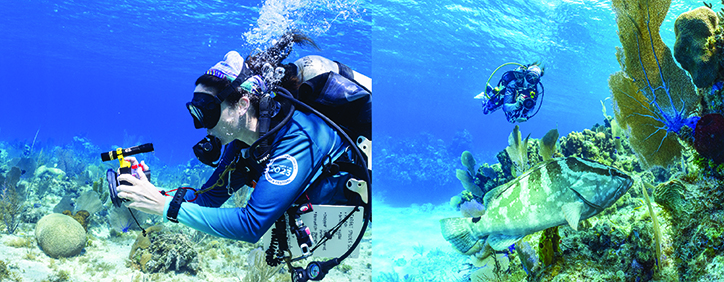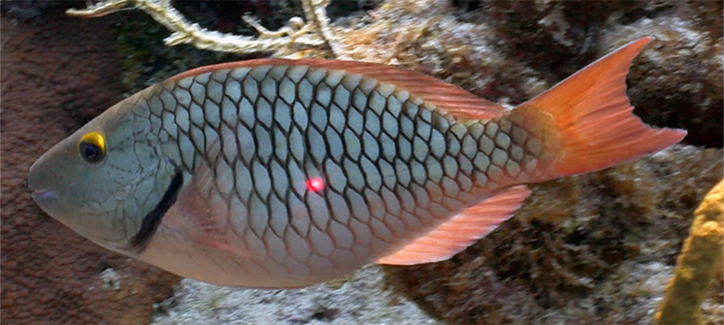- ABOUT US
- PROGRAM AREAS
- CONSERVATION APPROACH
- EDUCATION
- MULTIMEDIA
Fisheries science with a SMILE!
By: Jennifer Loch, PhD; Alli Candelmo, PhD; Julia Byrd; Brice Semmens, PhD
Takeaway: Citizen scientists are SCUBA diving with underwater, laser mounted cameras for the collaborative SMILE Project (Size Matters: Innovative Length Estimates). The cameras are used to obtain fish lengths while underwater, contributing data for management and conservation of economically and ecologically important reef fish species.

SMILE: Size Matters, Innovative Lengths Estimates
Fish lengths are an important source of information for fisheries managers when assessing the health of fish populations, especially for ecologically and economically important fishes. Thanks to funding from NOAA's Coral Reef Conservation Program, scientists are harnessing the power of affordable camera technology and scuba-diving citizen scientists in a new program aimed at capturing fisheries-independent length data. Through the SMILE (Size Matters: Innovative Lengths Estimates) project, volunteer scuba divers use low-cost, waterproof cameras equipped with a laser (see video) that allow for the measurement of fish captured in pictures using AI technology.
Traditional methods to collect fish lengths data require handling or harvesting the fish, which can impact local fish populations. Additionally, harvested fishes often represent a limited distribution of fish sizes and species due to harvest restrictions. Thus, incorporation of camera technology allows researchers to collect data on the full range of size classes as well as data on species that are not targeted as fisheries (ie., parrotfish or protected species like Nassau Grouper). This diver-deployed camera technology can better inform population assessments, particularly for data-limited fishes (i.e., those species for which little or no fisheries data exist). Citizen science programs like SMILE help bring new data sources into stock and ecosystem assessment processes while also empowering the public to generate monitoring data and promote active participation in resource management science.

Next Steps
Fieldwork for the SMILE project is currently focused in the Florida Keys, with great success thus far. The SMILE project complements REEF's existing Volunteer Fish Survey Project, which incorporates fish abundance data collected by citizen science divers since 1993 to form the world's largest marine life sightings database. These data are used by a variety of resource agencies and researchers and have contributed to numerous research publications. With the addition of fish length information, REEF's citizen science surveys will provide a more informative picture of reef fish communities and populations. Over the course of the SMILE project, the cameras and methodology will continue to be field tested and modified by project staff and volunteers in the Florida Keys as well as on international trips including in St Lucia, Cayman Islands, and Cuba. The SMILE project is funded through 2025 and will produce images and length data to be publicly available for research and management use, along with the advancement of the citizen science program and camera and AI technologies.
Related Stories and Products
About Us

The NOAA Coral Reef Conservation Program was established in 2000 by the Coral Reef Conservation Act. Headquartered in Silver Spring, Maryland, the program is part of NOAA's Office for Coastal Management.

The Coral Reef Information System (CoRIS) is the program's information portal that provides access to NOAA coral reef data and products.
Work With US
U.S. Coral Reef Task Force
Funding Opportunities
Employment
Fellowship Program
Contracting Assistance
Graphic Identifier
Featured Stories Archive

Access the archive of featured stories here...
Feedback
Thank you for visiting NOAA’s Coral Reef Conservation Program online. Please take our website satisfaction survey. We welcome your ideas, comments, and feedback. Questions? Email coralreef@noaa.gov.
Stay Connected
Contact Us
NOAA’s Coral Reef Conservation Program
SSMC4, 10th Floor
1305 East West Highway
Silver Spring, MD 20910
coralreef@noaa.gov
